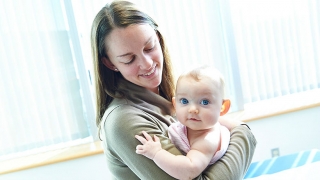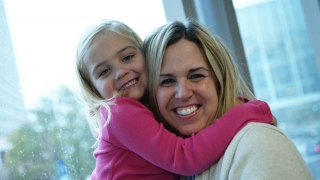Better Valves, Better Lives
In his first years as a pediatric cardiologist in the late 1970s, children born with heart defects faced a very difficult road. Many did not make it.
“It drove all of us crazy to stand by and see a child die like that,” recalls Robert J. Levy, MD.
Over the next 30 years, a legion of scientist-physicians, Dr. Levy among them, would rise to the many challenges presented by their patients’ hearts. From the beginning, he was fascinated by a particular problem: replacement valves for children with faulty heart valves. One option is mechanical (man-made) valves, which work well but are prone to blood clots. Children with mechanical valves take anticoagulants (“blood-thinners”) for their rest of their lives.
Another option is valves from animals, most commonly pigs. At the start of Levy’s career, these valves were working in adults, with no anticoagulants required. But in children, because they are experiencing rapid bone growth, the valves quickly became covered in calcium. Dr. Levy saw waves of patients returning to the hospital, often within months of surgery, severely ill with calcified valves.
Troubled by what he saw, Dr. Levy went to his lab and began searching for answers. Today his research team at The Children’s Hospital of Philadelphia is an international leader in the quest for better replacement valves.
Meaningful research takes time. Reflecting on the past decades, Dr. Levy says, “It was really the private philanthropy that kept us going. Because of that I was able to build my earliest research into the major projects we have now.”
Two generous donors, families of Cardiac Center patients, helped this progress. Richard and Ann Seidel have supported research for more than a decade through the Erin Beatty Endowed Fund for Cardiology Research, named for their granddaughter, a Cardiac Center patient who is now a healthy teenager. And Adam and Christine Kibel, whose son was treated at CHOP for an aortic valve defect, provide support through the Kibel Fund for Cardiac Research.
Levy’s work is ongoing. Through the efforts of his team, CHOP holds four valve-related patents. Tens of thousands of patients have the St. Jude Medical Epic Valve®, created by Levy. It is a porcine (pig) valve treated with a coating that slows calcification. Another of his valves, the St. Jude Medical Trifecta Valve, is in clinical trials.
As so often happens, Levy’s research has branched off in different directions.
Because heart valve disease is localized (in one place in the body; not systemic), his focus has been on treatments targeting one area. His team is now a leader in a burgeoning area of medical research: nanoparticles as targeted delivery systems for medicines and other therapeutics.
In a recent animal study, Dr. Levy’s team used uniform magnetic fields, comparable but far lower in magnetic strength than those present in MRI scanners, to drive iron-bearing nanoparticles to metal stents, tiny devices used to keep narrow or injured veins and arteries open. The nanoparticles slowly released medicine and prevented blockages. This localized treatment could prove helpful not only to heart patients, but also to the millions of diabetics who suffer from poor circulation because of damaged blood vessels.
Dr. Levy is also examining nanoparticles in another disease: the childhood cancer neuroblastoma. Dr. Levy is collaborating with Garrett Brodeur, MD, an oncologist at CHOP, in a study of nanoparticles as carriers of chemotherapy to tumors.
For Dr. Levy, the progress and the paths can be traced back to the children who were so sick, and even died, when he was a young doctor. Today, because of scientists like Dr. Levy, and their supporters, the vast majority of children with heart defects live. “It’s been revolutionary, what I’ve seen,” he says. “It’s miraculous. We’re talking about quality of life now, instead of mortality.”
From a seed, forests
When a philanthropist makes a large donation to the Cardiac Center, it is often only because of that donation that one of the many extra, groundbreaking projects in research or care is possible. In those cases, it is clear how the money given leads directly to expanded services. But the hundreds of modest gifts that come into the Cardiac Center every year also provide support for projects that could not happen otherwise.
For several years, the Cardiac Center has been allocating money from all of those donations made for the general support of the Center to provide seed money to promising research projects that would otherwise have no money to get started.
“The impact on my laboratory was quite significant, as the preliminary work that was collected with the help of the Cardiac Center was used to secure a two-year grant from the March of Dimes Foundation,” says Fraz Ahmed Ismat, MD, who was provided funding for his study of microRNA’s role in regulating the cardiac outflow tract. Dr. Ismat notes that knowledge of microRNA’s role in disease is currently advancing quickly, and that scientists suspect it plays a large part in fetal development and congenital heart disease.
Cardiac Center donors are funding other work at the leading edge of science. Michael Chorny, PhD, received funding for a study of using magnetically guided nanoparticles to aid with the recovery of the inner cell lining of an artery that has had a stent implanted.
“We developed biodegradable magnetic nanoparticles enabling genetic cell modification to improve their function and provide magnetically driven cell delivery to the injured arterial segment,” Chorny explains. “Our studies showed that after the magnetic nanoparticle treatment, the ability of cells to produce nitric oxide, an essential element in the normal vessel homeostasis, was significantly improved. In addition, our magnetic delivery strategy enabled efficient cell guidance and prolonged residence at the stented vessels, which was not achievable without the magnetic targeting.”
The results justified additional studies as the technique moves towards a possible place as a treatment for children in the Cardiac Center in the future.
In all, from 2007 through 2009, 21 research studies were supported by Cardiac Center donors. Through advancing basic and clinical science in all aspects of cardiac care, donors like you are building a better future for children with cardiac conditions.

